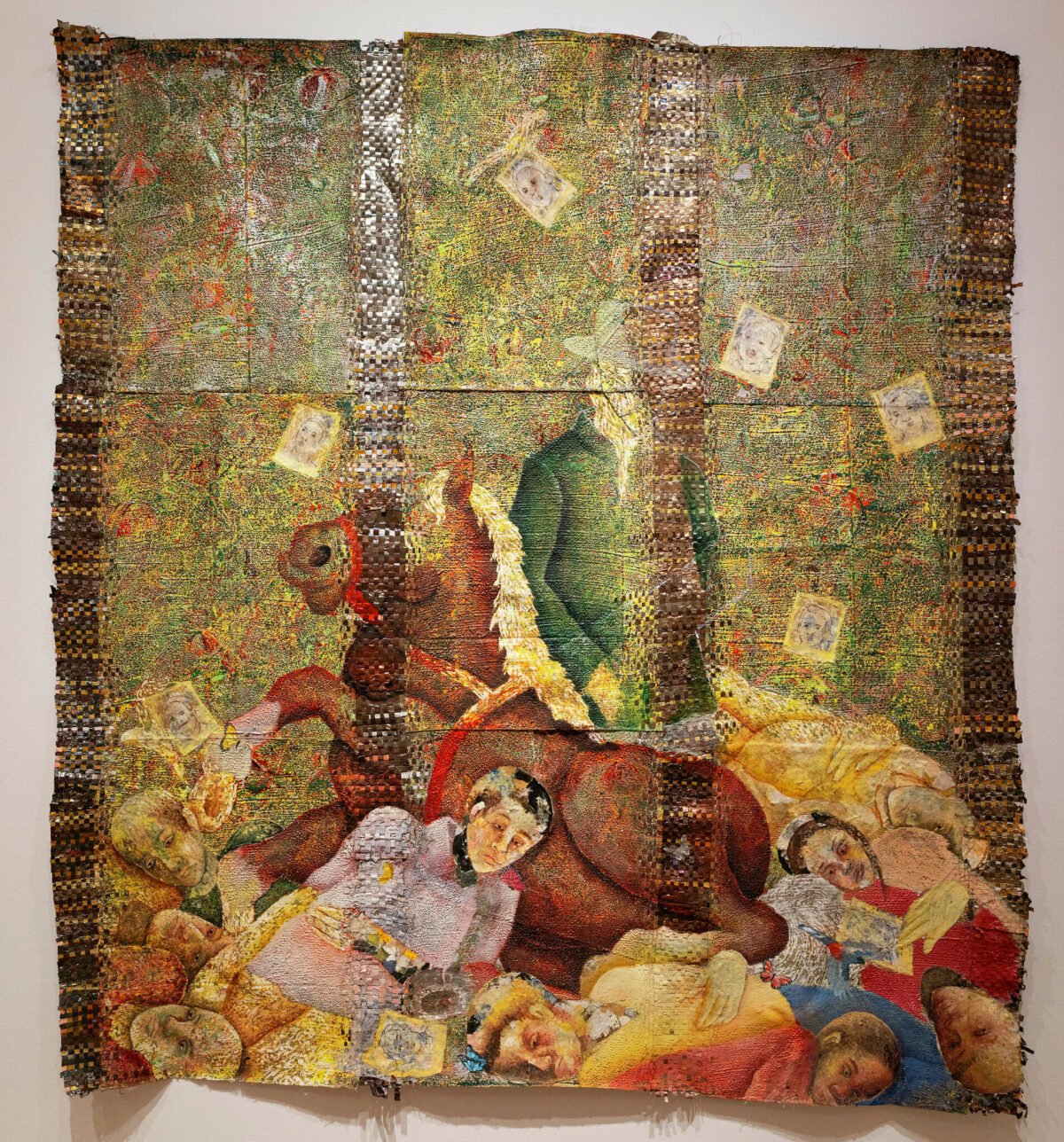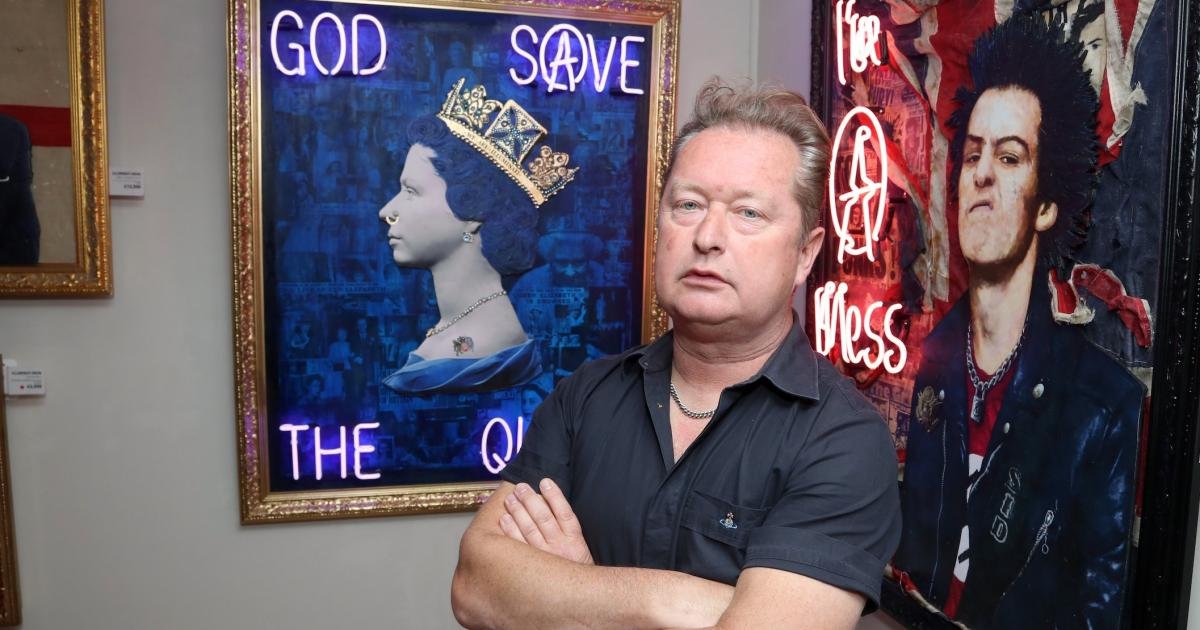Even from a distance, the first thing you might notice at “Kathia St. Hilaire: Invisible Empires,” in the Lunder Center up the hill at The Clark Art Institute, is how densely textural everything is. There are variously pieces upon pieces of canvas, paper, banana leaves, metal, and even tire fragments in these large collages. And there are layers upon layers of linocut ink—up to 50 in some works—as well as residuals from found printed materials in what are all printmaking effusions.
Up close, these densely pigmented surfaces, metallic sheens, Chiquita banana stickers, and bits of money make their own case, playing with your eyes in tactile ways. But that surely is not the soul of the work. Step back again and watch things congeal into sensible images—the forest for the trees—and this is where we get to its emphatic content: scenes and scenarios from Haiti’s long, troubled history.
St. Hilaire, born in Florida, educated at Yale and RISD, and working in New York, still identifies with her roots in Haiti, where her parents were born. She also draws from the strong and conflicting African and Caribbean influences of Miami, where she was raised. (This exhibit geographically aligns with The Clark’s one on 19th-century Hiatian-born artist Guillaume Lethière.)
Article continues below this ad
“Kathia St. Hilaire: Invisible Empires”
Where: The Clark Art Institute, Williamstown, Mass
When: through September 22
Hours: Tuesday–Sunday, 10 am–5 pm, September–June. Evening Hours (June 19–September 25, 2024 only): Wednesdays, 5 pm–9 pm Open daily in July and August, 10 am–5 pm. Closed Independence Day and Labor Day.
Free Summer Evenings: Wednesdays, 5 pm–9 pm (June 19–September 25 only)
Free for members, anyone age 21 and under, and students with a valid ID.
Info: https://www.clarkart.edu/microsites/kathia-st-hilaire/about-the-exhibition or 413-458-2303
Most of the works are depictions of sorts, some seemingly based on documentary sources, with figures arranged in a flat and often stiff manner. And most refer to events in Haitian history, such as the rather gruesome “Head Whisper,” which presents the infamous François Duvalier showing off the head of a political opponent to his secret service cadre. Large expanses of tactile, wrinkled and reflective browns surround key areas of greater detail, especially the impassive faces of the figures (as well as the head suspended from Papa Doc’s hand).
Three inter-related works, using similar materials, connect to one of the recurring tragedies of Haiti: oppression from outside. After Haiti’s 12-year slave rebellion beginning in 1791, France demanded payment on what it deemed was owed to slaveowners due to slaves being set free. These forced payments crippled the country’s economy for another century. Then, in the early 20th century, the United States had its own economic (and political) reasons for occupying the country for 20 years.
These three colorful works, each showing a figure on a horse with others around them, depict leading resistance fighters (two were eventually killed by U.S. Marines). The works act as paeans to heroes of Haitian self-determination. The imagery is quite complex, with background figures and busy collage work giving a sense of action in the air. The textural effects add to the fluency of the commentary, partly by including references to the problem, as with bits of banknotes worked into the design.
Article continues below this ad
Two of the largest works here are essentially abstract. One, a brownish spiral from floor to ceiling, is called “David” after the 1979 hurricane that devastated the island. The other, “La Sirene,” suggests ocean waves, referring to vodou water spirit, and therefore referencing (according to the texts in the gallery), the journey of slaves across the waters to Haiti.
These become a bit decorative, reminding us how important is the political content, as well as some spiritual currents. “Our Only Guide to Justice,” which features a central figure swinging a burning tire in protest over a group of recumbent women, combines all the elements at the artist’s disposal, including vodou symbolism, recent politics, and a diamond pattern of textural effects.
St. Hilaire, like many contemporary artists, mines a personal history to build a narrative about a particular culture. But for her this process is mostly a step removed, leaning into broad historical moments, flirting with that veritable but often staid history genre known for showing us instructive moments from the past. For St. Hilaire, the physical exuberance and embedded symbolism of the materials lift the art away from such grand illustration into a kind of borrowed mémoire, a challenge, and reminder of why Haiti still unfairly struggles.
Article continues below this ad













